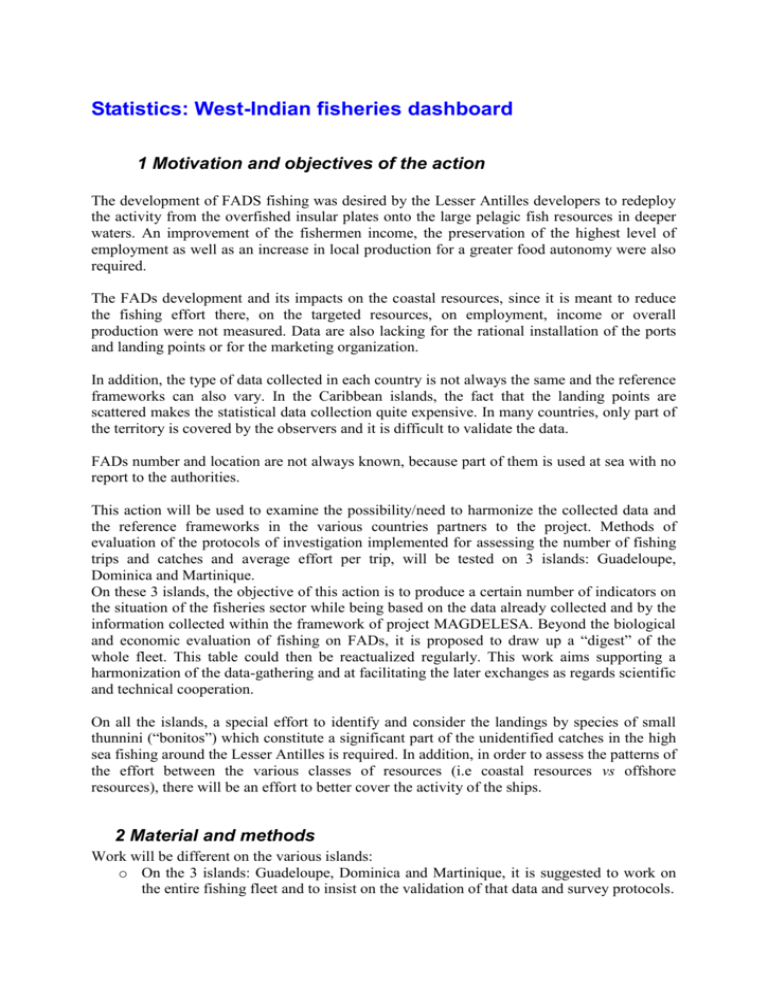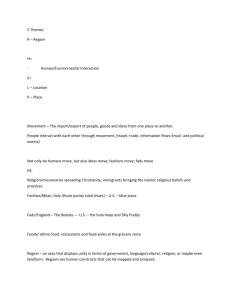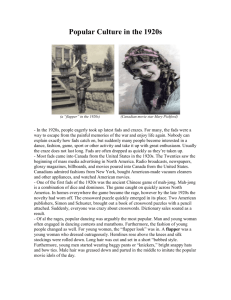Statistiques : Tableau de bord des pêcheries antillaises
advertisement

Statistics: West-Indian fisheries dashboard 1 Motivation and objectives of the action The development of FADS fishing was desired by the Lesser Antilles developers to redeploy the activity from the overfished insular plates onto the large pelagic fish resources in deeper waters. An improvement of the fishermen income, the preservation of the highest level of employment as well as an increase in local production for a greater food autonomy were also required. The FADs development and its impacts on the coastal resources, since it is meant to reduce the fishing effort there, on the targeted resources, on employment, income or overall production were not measured. Data are also lacking for the rational installation of the ports and landing points or for the marketing organization. In addition, the type of data collected in each country is not always the same and the reference frameworks can also vary. In the Caribbean islands, the fact that the landing points are scattered makes the statistical data collection quite expensive. In many countries, only part of the territory is covered by the observers and it is difficult to validate the data. FADs number and location are not always known, because part of them is used at sea with no report to the authorities. This action will be used to examine the possibility/need to harmonize the collected data and the reference frameworks in the various countries partners to the project. Methods of evaluation of the protocols of investigation implemented for assessing the number of fishing trips and catches and average effort per trip, will be tested on 3 islands: Guadeloupe, Dominica and Martinique. On these 3 islands, the objective of this action is to produce a certain number of indicators on the situation of the fisheries sector while being based on the data already collected and by the information collected within the framework of project MAGDELESA. Beyond the biological and economic evaluation of fishing on FADs, it is proposed to draw up a “digest” of the whole fleet. This table could then be reactualized regularly. This work aims supporting a harmonization of the data-gathering and at facilitating the later exchanges as regards scientific and technical cooperation. On all the islands, a special effort to identify and consider the landings by species of small thunnini (“bonitos”) which constitute a significant part of the unidentified catches in the high sea fishing around the Lesser Antilles is required. In addition, in order to assess the patterns of the effort between the various classes of resources (i.e coastal resources vs offshore resources), there will be an effort to better cover the activity of the ships. 2 Material and methods Work will be different on the various islands: o On the 3 islands: Guadeloupe, Dominica and Martinique, it is suggested to work on the entire fishing fleet and to insist on the validation of that data and survey protocols. o On the other islands: St Kitts, St Vincent, Grenada and Haiti, only a single test fleet shall be monitored. The test fleet will be chosen in the area facing the MAGDALESA experimental FADs. On all the islands, 4 levels of survey are suggested for implementation and testing during the action: 1. A census of the boats will be supplemented by the data collection on the activity of each ship (“calendar of activity”). The ships census data and activity will be collected using the suitable survey cards processed via an ACCESS software designed for this purpose for the English-speaking islands. 2. The average number of outings per boat will be estimated by an investigation at the landing spots, like what is used currently in the various Lesser Antilles countries. In the 3 islands (Guadeloupe, Dominica and Martinique), the results could be compared with other estimates made from fuel consumption or by weekly telephone surveys conducted according to a sampling plan developed on the basis of the ships census and investigations on the activity. 3. The investigations by fishing trips, currently carried out at the landing spots, will include the FADs fishing, the species caught using this technique (in particular the “bonitos”) and the fishing areas as a whole. Information on incomes and costs could also be collected during these investigations in order to assess the merits and yields of the various fishing techniques. A comparison between the average catches per outing, among the areas that are usually covered or not, by the data collection method could be undertaken on the 3 islands. In the same way, a comparison between data collected by telephone and investigations at the landing spots would enable to assess the quality of data according to the method used for collecting. 4. A biological sampling of the pelagic species caught in the vicinity of the FADs will be carried out during the surveys at the landing spots. Gonads samples will be taken during these (see action 3-biology and fishing). This work will be supplemented by an economic survey which will be conducted according to a sampling design drawn up from the activity data (see socio-economic action 4-Structure…). The results of this economic survey will be integrated into the fishing dashboard. For the data processing of items 2 to 4, it will be advisable to check that it can be done on the existing software in the various countries. Aerials surveys will be conducted in Martinique and Guadeloupe on two define geographic areas to determine the density of FADs. This will serve to determine the number of non registered FADs in order to evaluate the density of FADs. Follow up of catches in these areas will give an estimation of the impact of FAD density on captures. During the biological samplings which will be done at the landing spots, the FADs fish will be identified, the fork length will be recorded, and the length lower rostrum - fork, will be taken for the billfish. The individual weight will be also noted. On blackfin tuna, the gonads will be taken to be weighed and at least the gender and the maturity stage will be noted (see action 3-Biology and fishing). 3 Implementation Each island will work autonomously in the zone that is selected, but respecting the protocols common to all and in particular: the survey cards and the reference system defined. The software for capturing the data will, as far as possible, be the same for all. Une comparaison des données collectées et des référentiels utilisés dans chaque île sera effectuée dès le début du projet, afin de définir les adaptations nécessaires. L’inventaire de la flottille à suivre durant le projet sera réalisé dès le début, par chaque pays de façon à compléter les référentiels. The inventory of the fleet to be followed during the project will be done at the outset by each country, in order to complete the reference systems. The activity surveys will be done exhaustively on the fleet studied. These data of Guadeloupe, Dominica and Martinique will be processed with the assistance of a statistician, during the first meeting of the project. They will enable us to define the sampling plan that will be implemented on each island. Then, surveys will be undertaken routinely until the end of the project’s data collection period. These surveys could be carried out by telephoning the skippers or directly at the landing points for the effort and catch data (in the same way as for the economic data – see the economic action). A distinction will be made between data collected by surveying the skippers and observations undertaken by the pollster. At the same time as these surveys, biological sampling will be undertaken daily (or even more frequently, if the means available allow this) at the landing point. Each island will record and process its own data. Pooling this data for certain work will be done during meetings of all the partners. Technical assistance will be provided by Ifremer to define the work protocols (sampling plan, etc.), and the data capture and processing. 4 Work schedule o Months 1 and 2: inventory of the boats, inserting the reference systems. o Months 2 to 5: activity surveys destined to establish the activity calendars of all the boats in the zone studied and of at least one sample of the fleet of each island. o Month 6: Preparing the first meeting of the project. o Month 7: during the first meeting, elaborating the typologies using the activity calendar data and defining the sampling plans. o Months 8 to 21: collecting catch and effort data and biological sampling by regular presence at landing points, at those times. Removal of gonads and sample of fins will be taken for genetic study (see action 3-Biologiy & Fishing). o Month 22 and 23, final processing of data for meeting 3. Proposal of a fishing dashboard taking into account the quality of the data according to their nature. Supply of statistical data on the species caught around the FADs to international bodies (CRFM for blackfin tuna,…). o Month 12 and 16: Flight survey to assess the number of FADs and their frequentation in Guadeloupe and Martinique. The meetings with the partners of the project will be held: o Month 7: (see the objective above). o Month 18: presentation of the progress of the work and discussion of initial results. o Month 23: synthesis of the work and recommendations to be made at the outcome of the project. 5 Intervenants Ifremer (Brest): Support of a statistician to elaborate the typologies and the sampling plans. Ifremer (Martinique): coordinating the collection and processing of data in all the islands and collecting the data in Martinique. Participating in the synthesis work. Countries of the Caribbean: Collecting the data and processing it. Participating in the synthesis work. Country Antigua & Barbuda St Kitts & Nevis Guadeloupe Dominica Martinique Ste Lucia Barbados St Vincent & the Grenadines Grenada Haïti Zone of study Inventory of Fleet selected Calendar of activity Monitoring effort and catches Biol. Sample Opposite to the FADs All the Island All the Island All the Island X X X X X X X X X X X X X X X X Opposite to the FADs Opposite to the FADs Opposite to the FADs X X X X X X X X X X X X







